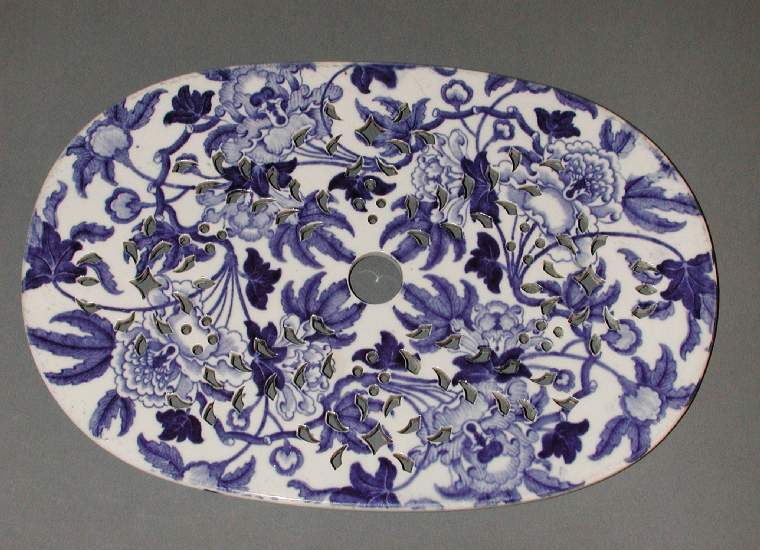Current Location: In storage
Maker(s)
Factory:
Wedgwood
Entities
Categories
Description
White earthenware, pierced and transfer-printed underglaze in blue with 'Peony' pattern. Oval with a rim on the underside of the outer edge, and a circular hole in the centre surrounded by piercing: four radiating lines of paired leaf shapes with between them four diamonds surrounded by leaf shapes and six groups of four small circles. This pierced pattern is obscured by the printed design of four sprays of peonies and foliage which entirely covers the top surface.
Notes
History note: Gabor Cossa (Joan Eve), Trumpington Street, Cambridge, where purchased
Legal notes
Purchased with the J. R. V. Smyth Fund
Measurements and weight
Length: 24.7 cm
Width: 16.8 cm
Acquisition and important dates
Method of acquisition: Bought
(1984-10-22)
by
Eve, Joan
Dating
George III
19th Century, Early
Circa
1807
-
1812
Note
Peony was one of several botanical patterns produced by Wedgwood following a decision to manufacture underglaze printed ware at the end of March 1805. It was described by the Wedgwood historian, Una des Fontaines, as 'probably one of the finest symmetrical flower patterns ever designed'. It was mentioned in the factory's records in 1806 and was in production from 1807. The engravings for the transfers were executed by William Hales (fl 1790-1815), possibly influenced by the Paeonia Suffructosa or shrubby peony illustrated in 'The Botanists' Repository' , vol. 7 (1806-07), pl. 448. John Wedgwood, who had rejoined the firm in 1800 and was largely responsible for its running in the first few years of the century, was keenly interested in botany, and was a founder member of the Royal Horticultural Society in 1804. After the death of Josiah Wedgwood I, the factory had not been doing well financially, and these printed floral patterns were intended to appeal to customers who enjoyed the highly fashionable enthusiasm for botany and gardening. The other printed botanical designs were 'Brown Water Lily' (see C. 3-1988), 'Hibiscus', 'Chrysanthemum', and 'Blue Botanical Flowers'. Blue transfer-printed ware is often viewed as a product for for the lower end of the market, but the splendid visual effect of a well-printed blue and white dinner service on highly polished mahogany or a white damask cloth should not be underestimated.
School or Style
botanical
Components of the work
Decoration
composed of
cobalt-blue
( in printing medium)
Holes
Materials used in production
White earthenware
Lead-glaze
Techniques used in production
Moulding
: White earthenware, moulded, pierced and transfer-printed underglaze in blue with 'Peony' pattern
Lead-glazing
Inscription or legends present
- Text: WEDGWOOD
- Location: On the back
- Method of creation: Impressed
- Type: Factory mark
Inscription present: '12' and two eyebrows incised
- Text: 12 and two eyebrows
- Location: On the back
- Method of creation: Incised
- Type: Mark
- Text: T
- Location: On the back
- Method of creation: Underglaze in blue
- Type: Mark
References and bibliographic entries
Identification numbers
Accession number: C.864-1984
Primary reference Number: 11966
Stable URI
Audit data
Created: Saturday 6 August 2011
Updated: Tuesday 30 April 2024
Last processed: Tuesday 13 May 2025
Associated departments & institutions
Owner or interested party:
The Fitzwilliam Museum
Associated department:
Applied Arts




